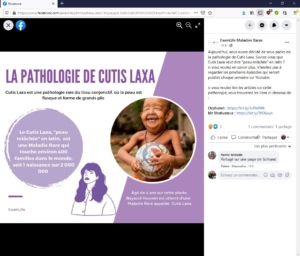Cutis Laxa Videos…… N°1
Here is the first of 8 videos edited by EwenLife on their Youtube Channel
Marie-Claude Boiteux explains what Cutis Laxa is and the different types.
It is in French, but here is how you can get subtittles in your own language

Here is the first of 8 videos edited by EwenLife on their Youtube Channel
Marie-Claude Boiteux explains what Cutis Laxa is and the different types.
It is in French, but here is how you can get subtittles in your own language

EwenLife is dedicated to rare disorders. They made an interview with Marie-Claude Boiteux to publish videos talking about Cutis Laxa: what it is, the diagnosis, treatments, Cutis Laxa Internationale, etc
Once a week, on sunday, they will edit one video. And there are 8 videos. We are sorry there was no funds to get them subtittled in English we hope you can understand French.
Here is the teaser announcing the videos on their facebook page
They also talked about Cutis Laxa on their facebook page

Here is their Youtube channel where the videos are posted.
ENJOY watching them !
Since Cutis Laxa Internationale was set up, we have received many patients’ and parents’ testimonies.
They are now collected in a newly published book :
« Cutis Laxa, Story of a Rare Disorder, Patients’ testimonies ».
It is available in French, English and Spanish. We will send it to you on request, at €25 per copy.
Orphanet has just edited its new study about rare disorders in France.
You can read here the whole study (in French)
On 23rd February 2021, celebrating 2021 Rare Disease Day, Eurordis held the “Rare 2030 Final Policy Conference”.
Over 1100 participants representing all stakeholders groups of the rare disease community took part in this event, learning, exchanging and celebrating together.
Find here the Rare 2030 Recommandations
Have a look at Rare 2030 website
Cécile was diagnosed in 1992.
8 years later, she appeared for the first time on TV screens.
On 11th November 2001 we set up Cutis Laxa Internationale. But there was no research programm. We knew of 9 patients.
One month later, we appealled on TV screens during the Telethon (Fudraising event). We needed a 10th patient for a research programm to be launched.
Annie Moissin, who was responsible for relationship with patients for orphan disorders at that time, heard our call. She tells here (in French) what happened next.
Thanks to you Annie,
Thanks to Solhand of which you are now the Chair.,
One can do nothing alone, Together we are stronger, we go further.
Marie-Claude Boiteux
Chair of Cutis Laxa Internationale, Cécile’s mother
The French monthly magazine “La Revue du Praticien” (The Medical Practitioner’s Journal) published an article on Cutis Laxa in its November issue.
Read the article here (in French)
We have developped 2 patient journeys based on testimonies from our members on what it is like to live with a Cutis Laxa.
Those documents aim to be a tool for health care professionals and patients during a consultation to help them agree on the best possible care on a long term basis.
They will be updated as often as needed to fit with the patients’ daily life and the most recent findings and treatments.
CUTIS LAXA WITH ARTERIES AND LUNGS SYMPTOMS
CUTIS LAXA WITH NEURO AND SKELETON SYMPTOMS
SAVE THE DATES
The 6th Cutis Laxa Days will be held at the University Hospital of Ghent( Belgium)
on 14th, 15th and 16th September 2022
This site uses cookies. By continuing to browse the site, you are agreeing to our use of cookies.
OKLearn moreYou can read about our cookies and privacy settings in detail on our Privacy Policy Page.
Privacy Policy